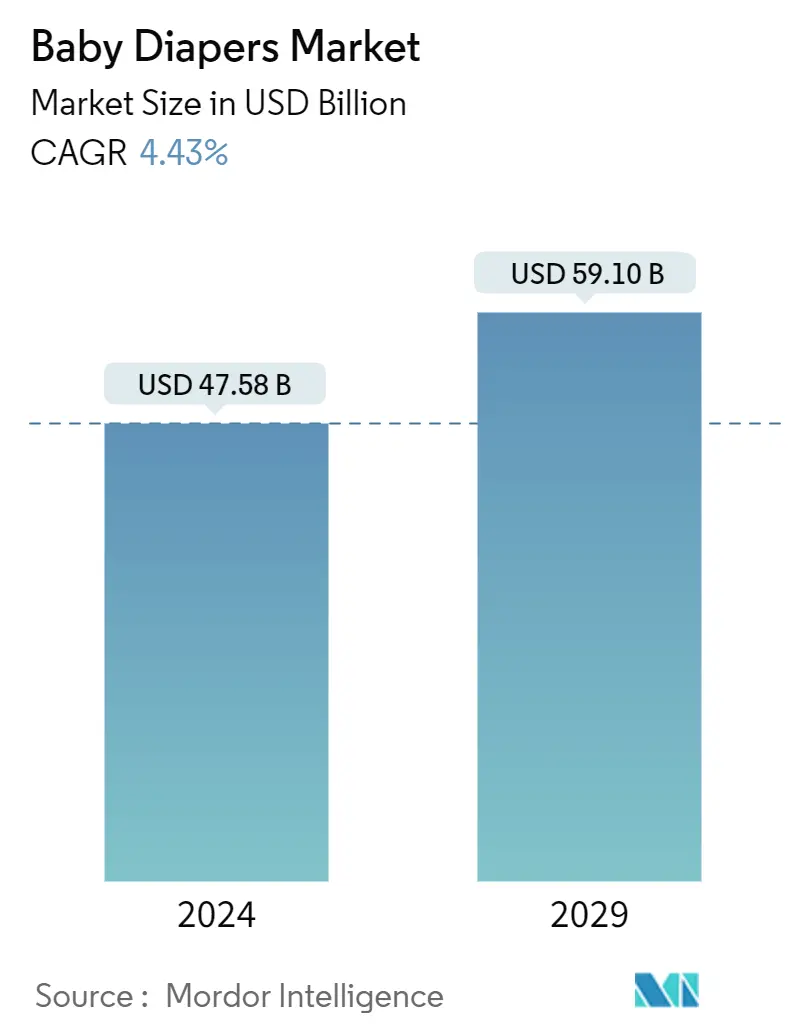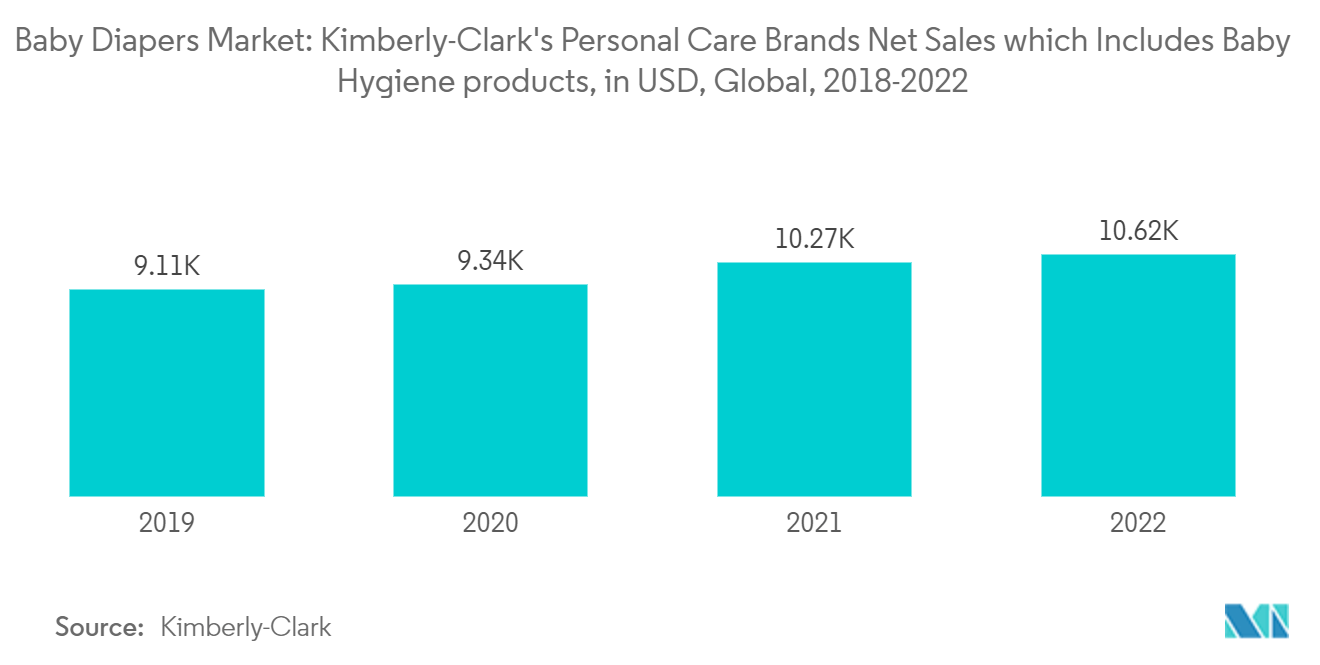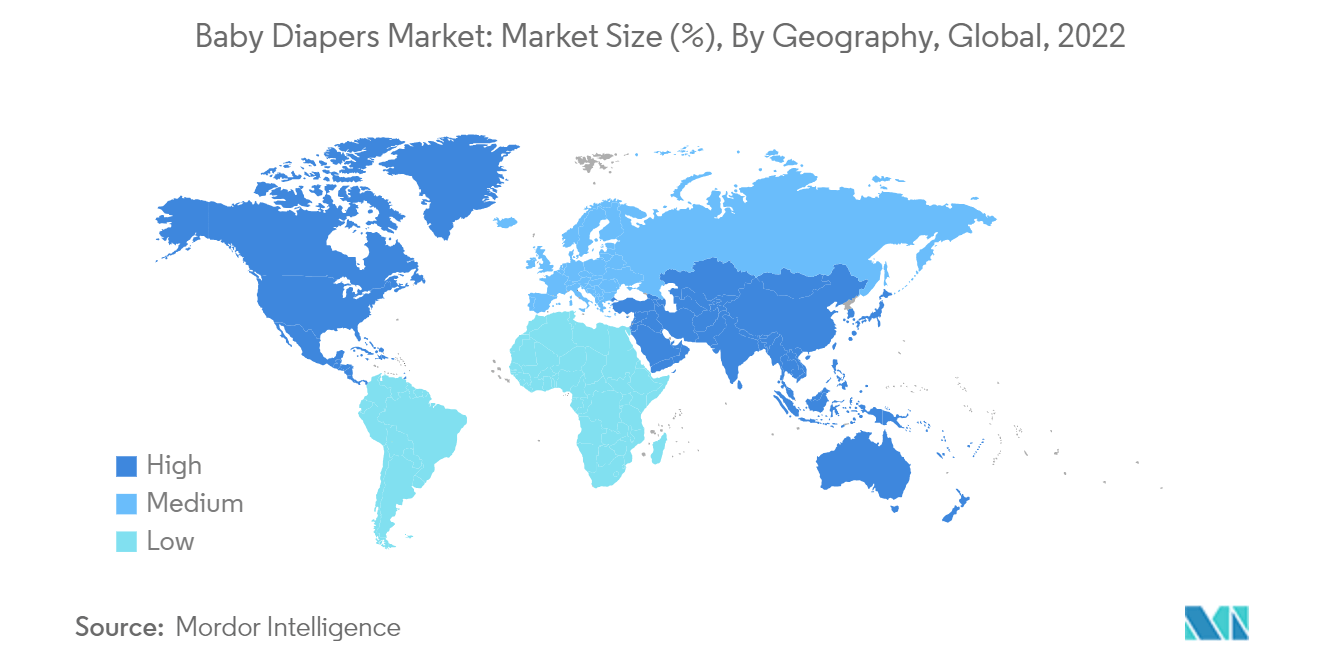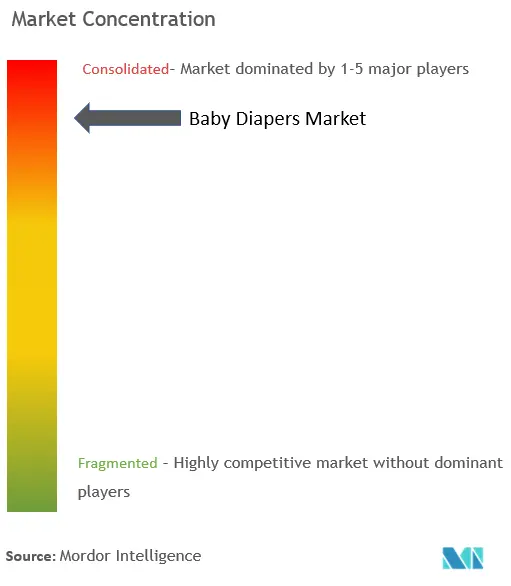Baby Diaper Market Size

| Study Period | 2019 - 2029 |
| Market Size (2024) | USD 47.58 Billion |
| Market Size (2029) | USD 59.10 Billion |
| CAGR (2024 - 2029) | 4.43 % |
| Fastest Growing Market | Asia Pacific |
| Largest Market | North America |
| Market Concentration | High |
Major Players.webp)
*Disclaimer: Major Players sorted in no particular order |
Baby Diaper Market Analysis
The Baby Diapers Market size is estimated at USD 47.58 billion in 2024, and is expected to reach USD 59.10 billion by 2029, growing at a CAGR of 4.43% during the forecast period (2024-2029).
The rising population, accompanied by the increasing urban population, is one of the most significant contributors to the market's growth. Besides that, the growing disposable income of the people, the rising female working population, the increasing rate of literacy, etc., are some of the factors that determine the living standards and consumption patterns of families and are also expected to serve as essential growth factors. Consumers' growing health and hygiene concerns will likely drive the market in the coming years.
Additionally, owing to the increasing awareness regarding maintaining the hygiene of infants, parents have strongly adopted the usage of baby diapers. Ongoing advancements in the fabric used in a diaper, absorption capabilities, and special user-friendly features of diapers have led to competitors gaining a higher market share. Increasing demand for natural and hygienic products is driving manufacturers to develop bio-based disposable diapers, which is also projected to propel market demand.
Market players are engaged in innovating diaper technology. Some key trends in the diaper market include eco-friendly/bio-degradable diapers, electronic diapers, organic diapers, and pant-style diapers.
Baby Diaper Market Trends
Increasing Awareness about Baby Hygiene
- Owing to the increasing awareness about infant hygiene, parents are strongly adopting the usage of baby diapers. Diapers are among the essential infant daily care products and baby wipes, which help prevent bacterial infection and provide comfort. The growing concern about diaper rashes, often related to wet or infrequently changed diapers, is augmenting the demand for baby diapers worldwide.
- Brands like Huggies and Pampers provide a range of rash-free diapers, having unique technology to prevent leakage and decrease irritation. A single baby uses 7-8 diapers daily, meaning the diaper is used for almost 24 hours a day. This factor increased consumers' inclination toward cotton-based diapers to avoid skin allergies caused by synthetic diapers.
- In July 2021, SuperBottoms, India's cloth diaper brand, launched the UNO 2.0 for new parents to use on their babies. All diapers are made from 100% cloth and have organic cotton pads. A number of government institutions have also launched health awareness campaigns specifically aimed at raising awareness among young parents about their children's health and hygiene.
- For instance, in February 2022, through its Latin American Centre for Perinatology (CLAP), the Pan American Health Organization (PAHO) launched a campaign to raise awareness about newborns and promote quality care practices in the first 28 days of life. Skin-to-skin contact, exclusive breastfeeding, and keeping the baby clean and dry are a few of these practices.

Asia-Pacific Witnessed Significant Growth
- In the baby care category, one of the main factors driving the growth of the market is the growing number of working women in the population of the region. World Bank data indicates that the female labor participation rate in East Asia Pacific has increased significantly from 43.7% in 2016 to 43.94 % in 2021.
- Furthermore, the digital revolution has been a major factor in enabling the industry to grow at an accelerating rate. According to the National Family Health Survey (NFHS) of India, in 2021, 33% of women (urban+rural) and 52% of urban women had Internet access. Consequently, this is aiding the growth of the market in the region.
- In the Asia-Pacific region, China alone records the birth of approximately 18 million babies every year. The country accounts for the major share of the overall baby diaper market. The declaration of the third-child policy in China has played a great role in increasing the demand for baby diapers.
- Moreover, a wider distribution network and easy availability of numerous brands in the local markets led the key players to expand their sales to reach the inland markets. India also adds to the rising sales of diapers in the region.
- Along with international players like Unicharm and Procter & Gamble, many Indian players like Godrej and Himalaya are coming up with new varieties of baby diapers. The market is also witnessing product innovations to cater to changing customer needs. In March 2022, SuperBottoms, an Indian baby care brand, launched 100% eco-friendly, washable soft cloth diapers for babies, which helps prevent rashes and irritation.

Baby Diaper Industry Overview
The market studied is highly competitive, with many regional and global players. The major strategies adopted by these companies include product innovations, expansions, and mergers and acquisitions. The market is primarily dominated by Procter & Gamble, Kimberly-Clark Corporation, Kao Corporation, Unicharm, and Essity Aktiebolag.
The presence of private-labeled brands is expected to augment the competition. Moreover, Procter & Gamble and Kimberly-Clark Corporation have adopted product innovation as their key strategy to increase their market share and category growth over the years. The companies invested heavily in their R&D sectors to launch innovative products in the market and tap into the ongoing interest of consumers in sustainable baby products, including baby diapers.
Baby Diaper Market Leaders
-
Unicharm
-
Kimberly-Clark
-
Essity Aktiebolag
-
Procter & Gamble
-
KAO Corporation
*Disclaimer: Major Players sorted in no particular order

Baby Diaper Market News
- April 2023: Millie Moon baby diapers announced their launch in Canada. Millie Moon claims to be a clean, luxury diaper brand offering high-performance and beautifully crafted diapers and sensitive wipes at affordable prices. Further, Millie Moon Luxury Diapers feature double leak guards to keep wetness contained, a snug and high waistband for a secure fit, and an ultra-absorbent core to help prevent blowouts and leaks. The company also claims that the materials in its Luxury Diapers are extremely soft on babies' skin and engineered with CloudTouch Softness for optimum comfort.
- January 2023: Kimberly-Clark announced the relaunch of its iconic diaper brand, Huggies, with the new 'Huggies Complete Comfort' range in India. The relaunch emphasizes the basic concept of 5-in-1 comfort, which incorporates essential characteristics such as softness and absorbency. The company plans to implement an entirely new visual language for its packaging design across the range, emphasizing the brand's primary features and consumer benefits.
- May 2022: SUMO introduced a long-lasting fitted cloth baby diaper with a waterproof cover, a stitched pocket, and washable absorbent pads. They are completely biodegradable and feature a reusable diaper system.
- March 2022: As part of its expansion plans in Nigeria, Kimberly-Clark opened a new manufacturing facility in Ikorodu, Lagos, which will manufacture Huggies baby diapers as well as Kotex feminine care products. With the investment of USD 100 million in its new state-of-the-art manufacturing facility, the company is equipped with the latest technology to serve its customers better.
Baby Diaper Market Report - Table of Contents
1. INTRODUCTION
1.1 Study Assumptions and Market Definition
1.2 Scope of the Study
2. RESEARCH METHODOLOGY
3. EXECUTIVE SUMMARY
4. MARKET DYNAMICS
4.1 Market Drivers
4.2 Market Restraints
4.3 Porter's Five Forces Analysis
4.3.1 Threat of New Entrants
4.3.2 Bargaining Power of Buyers/Consumers
4.3.3 Bargaining Power of Suppliers
4.3.4 Threat of Substitute Products
4.3.5 Intensity of Competitive Rivalry
5. MARKET SEGMENTATION
5.1 Product Type
5.1.1 Cloth Diapers
5.1.2 Disposable Diapers
5.2 Distribution Channel
5.2.1 Supermarkets/Hypermarkets
5.2.2 Convenience/Grocery Stores
5.2.3 Pharmacy/Drug Stores
5.2.4 Online Retail Channels
5.2.5 Other Distribution Channels
5.3 Geography
5.3.1 North America
5.3.1.1 United States
5.3.1.2 Canada
5.3.1.3 Mexico
5.3.1.4 Rest of North America
5.3.2 Europe
5.3.2.1 Germany
5.3.2.2 United Kingdom
5.3.2.3 France
5.3.2.4 Italy
5.3.2.5 Russia
5.3.2.6 Spain
5.3.2.7 Rest of Europe
5.3.3 Asia-Pacific
5.3.3.1 India
5.3.3.2 China
5.3.3.3 Japan
5.3.3.4 Australia
5.3.3.5 South Korea
5.3.3.6 Rest of Asia-Pacific
5.3.4 South America
5.3.4.1 Brazil
5.3.4.2 Argentina
5.3.4.3 Rest of South America
5.3.5 Middle-East and Africa
5.3.5.1 South Africa
5.3.5.2 Saudi Arabia
5.3.5.3 Rest of Middle-East and Africa
6. COMPETITIVE LANDSCAPE
6.1 Market Share Analysis
6.2 Most Adopted Strategies
6.3 Company Profiles
6.3.1 Procter & Gamble Co.
6.3.2 Kimberly-Clark Corporation
6.3.3 Essity Aktiebolag
6.3.4 Kao Corporation
6.3.5 Domtar Corporation
6.3.6 Daio Paper Corporation
6.3.7 Ontex Group
6.3.8 Nuggles Designs Canada
6.3.9 Unicharm Corporation
6.3.10 Winc Design Limited
- *List Not Exhaustive
7. MARKET OPPORTUNITIES AND FUTURE TRENDS
Baby Diaper Industry Segmentation
A diaper is a piece of toweling or other absorbent material wrapped around a baby's bottom and between its legs to absorb and retain urine and feces.
The baby diapers market is segmented by product type, distribution channel, and geography. Based on product type, the market is segmented into Cloth Diapers and Disposable Diapers. Based on distribution channels, the market is segmented into supermarkets/hypermarkets, convenience/grocery stores, pharmacy/drug stores, online retail channels, and other distribution channels. Also, the study analyzes the dietary supplements market in emerging and established markets worldwide, including North America, Europe, Asia-Pacific, South America, the Middle East, and Africa.
The market sizing has been done in value terms in USD for all the abovementioned segments.
| Product Type | |
| Cloth Diapers | |
| Disposable Diapers |
| Distribution Channel | |
| Supermarkets/Hypermarkets | |
| Convenience/Grocery Stores | |
| Pharmacy/Drug Stores | |
| Online Retail Channels | |
| Other Distribution Channels |
| Geography | |||||||||
| |||||||||
| |||||||||
| |||||||||
| |||||||||
|
Baby Diaper Market Research FAQs
How big is the Baby Diapers Market?
The Baby Diapers Market size is expected to reach USD 47.58 billion in 2024 and grow at a CAGR of 4.43% to reach USD 59.10 billion by 2029.
What is the current Baby Diapers Market size?
In 2024, the Baby Diapers Market size is expected to reach USD 47.58 billion.
Who are the key players in Baby Diapers Market?
Unicharm, Kimberly-Clark, Essity Aktiebolag, Procter & Gamble and KAO Corporation are the major companies operating in the Baby Diapers Market.
Which is the fastest growing region in Baby Diapers Market?
Asia Pacific is estimated to grow at the highest CAGR over the forecast period (2024-2029).
Which region has the biggest share in Baby Diapers Market?
In 2024, the North America accounts for the largest market share in Baby Diapers Market.
What years does this Baby Diapers Market cover, and what was the market size in 2023?
In 2023, the Baby Diapers Market size was estimated at USD 45.47 billion. The report covers the Baby Diapers Market historical market size for years: 2019, 2020, 2021, 2022 and 2023. The report also forecasts the Baby Diapers Market size for years: 2024, 2025, 2026, 2027, 2028 and 2029.
What are the top trends in eco-friendly diaper production?
The top trends in eco-friendly diaper production are a) Biodegradable materials b) Plant-based ingredients c) Sustainable packaging
Baby Diaper Industry Report
The global baby diapers market is experiencing significant growth, driven by increasing awareness of child health, rising disposable incomes, and a growing number of working women. The market analysis indicates that disposable diapers dominate due to their convenience and hygiene, yet there is a noticeable shift towards eco-friendly, non-disposable alternatives, reflecting heightened environmental awareness among consumers.
Market research reveals a demand for both conventional and organic products, with organic options gaining popularity due to health and ecological concerns. The distribution of these products spans both offline and online channels, with online retail channels poised for rapid growth due to their convenience and variety.
The Asia Pacific region is expected to lead market growth due to its vast population, urbanization, and improving living standards. Meanwhile, North America and Europe show a preference for premium products, driven by substantial purchasing power. Market segmentation and market trends suggest that the competitive landscape is characterized by relentless innovation, focusing on sustainability and user-friendliness to meet modern parental needs.
Industry analysis highlights that the market outlook is positive, with market leaders continuously pushing for advancements. Industry reports and industry statistics provide a comprehensive view of the market size, market value, and market share, offering detailed insights into market data and market forecast. The industry research underscores the importance of industry trends and market predictions in shaping the future of the diaper market.
For a detailed market overview, including market review and industry sales, refer to the industry information available in Mordor Intelligence™ Industry Reports. These reports provide a thorough industry outlook and a free report PDF download for an in-depth understanding of the market dynamics.



